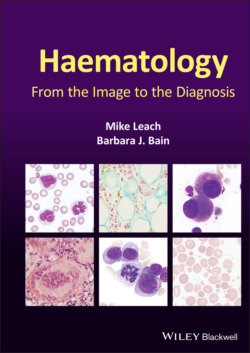Читать книгу Haematology - Barbara J. Bain, Irene Roberts - Страница 32
Оглавление23 Reactive eosinophilia
A 79‐year‐old man with a 60‐year smoking history presented with the recent onset of anorexia and weight loss with rapidly appearing skin nodules. He had no new respiratory symptoms though he had a longstanding cough attributed to chronic obstructive pulmonary disease. His full blood count showed Hb 133 g/l, WBC 58 × 109/l, eosinophils 35 × 109/l and platelets 500 × 109/l. The blood film confirmed a marked eosinophilia with a number of abnormalities of eosinophil morphology. Hypogranular eosinophils are prominent (all images ×100 objective) with some cells showing 50% loss of cytoplasmic granules (top left). There is also eosinophil cytoplasmic vacuolation (bottom left) and some basophilic granulation (top centre and bottom right). Finally, there are cells with nuclear abnormalities with some showing separation of nuclear components (top right) and even a ring nucleus (bottom centre). It might be assumed that such dramatic morphological abnormalities indicate a primary haematological disorder but this is not the case. A CT scan of chest, abdomen and pelvis showed a solid pulmonary lesion with irregular margins, mediastinal lymphadenopathy and bilateral adrenal masses. A skin biopsy showed a poorly differentiated carcinoma of possible primary lung origin.
Eosinophil morphology has intrigued experienced morphologists for decades. In contrast to neutrophils, dysplastic features are actually very common in reactive eosinophilias and morphological features are not reliable in predicting when eosinophilia might be a component of a myeloid neoplasm (Goasguen et al. 2020). It is important therefore to interpret all available investigative data and to consider reactive eosinophilia even when morphological abnormalities are apparent (Leach 2020). The fruitless pursuit of a primary haematological disorder could divert from the actual diagnosis. It did not delay diagnosis in the patient described as easily accessible skin tissue was available but in other patients this might not necessarily be the case.
References
1 Goasguen JE, Bennett JM, Bain BJ, Brunning R, Zini G, Vallespi M‐T et al.; International Working Group on Morphology of MDS (2020) The role of eosinophil morphology in distinguishing between reactive eosinophilia and eosinophilia as a feature of a myeloid neoplasm. Br J Haematol, 191, 497–504.
2 Leach M (2020) The diagnostic utility of eosinophil morphology. Br J Haematol, 191, 325.
MCQ
1 Reactive eosinophilia can occur in:Acute lymphoblastic leukaemiaAcute myeloid leukaemia associated with inv(16)BabesiosisFilariasisStrongyloidiasisFor answers and discussion, see page 206.
